|
|
|
Sort Order |
|
|
|
Items / Page
|
|
|
|
|
|
|
| Srl | Item |
| 1 |
ID:
182976


|
|
|
|
|
| Summary/Abstract |
This article explores how competing actors established, spread, and challenged visual representations of the Chinese nation during the COVID-19 pandemic. It asks: how do official gatekeepers of meaning in China imbue their visual construction of a crisis-hit nation with pathos?; and what happens when their critics utilize the resulting repertoire of visual cues for their own ends? To answer these questions, the article first examines the visual libraries of nationalism and national crisis from which Chinese propaganda drew during the COVID-19 outbreak. It then analyses the struggles that ensued over such representations, specifically the use of national flags and the sentiments they elicit. The analysis traces representations of the flag of the People’s Republic of China (PRC) from an initial satirical portrayal in a Danish broadsheet to the angry Chinese backlashes that followed on social media, and it shows how the tensions over such portrayals became part of a meme war over the sovereignty of Hong Kong. The analysis shows how representations of the nation can become a matter of existential anxieties during a time of crisis, especially in highly networked communication environments where authoritative official actors and their supporters are no longer in control of the symbols they established as part of their ‘emotional governance’.
|
|
|
|
|
|
|
|
|
|
|
|
|
|
|
|
| 2 |
ID:
182450
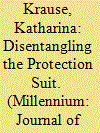

|
|
|
|
|
| Summary/Abstract |
The protection suit is the icon of infectious disease outbreaks. I argue that the protection suit has performative power not only by shaping the daily tasks of health workers and their interaction with patients, but also as a visual artefact and as a two-dimensional image determining how health crises and their security implications are understood and dealt with. The article proceeds in three steps: it firstly highlights the current absence of visuality in the academic literature on health security and makes the case for including it in the debate. Secondly, with recourse to Actor-Network Theory (ANT) it theoretically locates visual representations, as images and artefacts, as actors that act and enact each other in the health-security nexus. The third part of the article follows the protection suit during the Ebola epidemic in West Africa and maps the visual network it creates. In doing so this article demonstrates how the suit as artefact and image constitutes a network that visually and sensually links the bodies of patients, health workers and distant viewers in complex and at times competing makings of health security.
|
|
|
|
|
|
|
|
|
|
|
|
|
|
|
|
| 3 |
ID:
151189
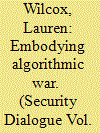

|
|
|
|
|
| Summary/Abstract |
Through a discussion of drone warfare, and in particular the massacre of 23 people in the Uruzgan province in Afghanistan in 2010, I argue that drone warfare is both embodied and embodying. Drawing from posthuman feminist theorists such as Donna Haraway and N Katherine Hayles, I understand the turn toward data and machine intelligence not as an other-than-human process of decisionmaking that deprives humans of sovereignty, but as a form of embodiment that reworks and undermines essentialist notions of culture and nature, biology and technology. Through the intermediation of algorithmic, visual, and affective modes of embodiment, drone warfare reproduces gendered and racialized bodies that enable a necropolitics of massacre. Finally, the category of gender demonstrates a flaw in the supposed perfectibility of the algorithm in removing issues of identity or prejudice from security practices, as well as the perceptions of drone assemblages as comprising sublime technologies of perfect analysis and vision. Gender as both a mode of embodiment and a category of analysis is not removed by algorithmic war, but rather is put into the service of the violence it enables.
|
|
|
|
|
|
|
|
|
|
|
|
|
|
|
|
| 4 |
ID:
160449
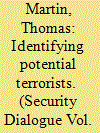

|
|
|
|
|
| Summary/Abstract |
This article analyses how British counter-radicalization policy in general, and the Channel project in particular, constitute individuals who are vulnerable to radicalization as visible, producing them as subjects of intervention. It thus asks, how can potential terrorists be identified and made knowable? The article first argues that to understand Channel, it is crucial to develop a conceptual account of the security politics of (in)visibilization that draws attention to the ways in which security regimes can, at times, function primarily through the production of regimes of (in)visibility. Using this approach, the article focusses on the role of ‘indicators’ as a technology of (in)visibilization. This role is central to the functioning of Channel, visibilizing certain subjects as threatening. Yet such a production is political. In bringing together a politics of care and a politics of identity, it is a regime of (in)visibility that produces new sites of intervention, contains significant potential consequences for the expression of certain identities, and raises new and troubling possibilities for how contemporary life may be secured.
|
|
|
|
|
|
|
|
|
|
|
|
|
|
|
|
| 5 |
ID:
172426
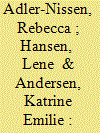

|
|
|
|
|
| Summary/Abstract |
How are images, emotions, and international politics connected? This article develops a theoretical framework contributing to visuality and emotions research in International Relations. Correcting the understanding that images cause particular emotional responses, this article claims that emotionally laden responses to images should be seen as performed in foreign policy discourses. We theorise images as objects of interpretation and contestation, and emotions as socially constituted rather than as individual ‘inner states’. Emotional bundling – the coupling of different emotions in discourse – helps constitute political subjectivities that both politicise and depoliticise. Through emotional bundling political leaders express their experiences of feelings shared by all humans, and simultaneously articulate themselves in authoritative and gendered subject positions such as ‘the father’. We illustrate the value of our framework by analysing the photographs of Alan Kurdi, a three-year-old Syrian-Kurdish boy who drowned in September 2015. ‘Kurdi’ became an instant global icon of the Syrian refugee crisis. World leaders expressed their personal grief and determination to act, but within a year, policies adopted with direct reference to Kurdi's tragic death changed from an open-door approach to attempts to stop refugees from arriving. A discursive-performative approach opens up new avenues for research on visuality, emotionality, and world politics.
|
|
|
|
|
|
|
|
|
|
|
|
|
|
|
|
| 6 |
ID:
172546


|
|
|
|
|
| Summary/Abstract |
Visuals are powerful mediators of global political events. Images, moving and still alike, are significant objects that play a role in shaping our understanding of international affairs. Through their multiple interpretations, these visuals can both represent reality and condition how we understand it. Within International Relations, there has been growing attention to the visual, with explorations of a wide range of theoretical concerns and empirical focuses. For instance, contributors to the burgeoning field of visual politics examine the affective power of images, how images become securitized and their role in framing politics.
|
|
|
|
|
|
|
|
|
|
|
|
|
|
|
|
| 7 |
ID:
160120


|
|
|
|
|
| Summary/Abstract |
As Donald Trump’s presidential campaign showed, walls are a hot topic. While ‘globalisation’, with its free flow of capital and goods, characterised world politics after the end of the Cold War, the twenty-first century has witnessed a reassertion of cultural, legal, and physical barriers. It is common to criticise such post-Cold War walls, especially the US-Mexico Barrier and Israel’s West Bank Barrier, as ineffective and immoral. This article problematises such critical discourse by using unlikely juxtapositions (the Great Wall of China) and new conceptual frameworks (gaps, critical aesthetics) to explore: (1) how walls can be a rational security policy; (2) how they are not simply barriers, but can be complex sites of flows; and (3) how walls are not simply texts waiting to be decoded: they are also sites of non-narrative affective experience that can even excite the sublime. This critical juxtaposition of walls first explores what they can tell us about the politics of borders, identity, and foreign policy, and then considers how walls, as concrete visual artefacts, can be examples not simply of ideology, but also of affect. The article aims to understand walls in a different register as active embodiments of political debate – and of political resistance.
|
|
|
|
|
|
|
|
|
|
|
|
|
|
|
|
| 8 |
ID:
173399


|
|
|
|
|
| Summary/Abstract |
Marysia Zalewski's Feminist International Relations: Exquisite Corpse on feminism and global politics directly addresses matters of style, that is, questions of language and representation that foreground the invisible yet so palpable aspect of how meanings circulate. This article puts Zalewski's work in conversation with Trinh Minh-ha's D-Passage: The Digital Way and Lynda Barry's What It Is that similarly push the limits of how we craft feminist arguments. These feminists show how styles of writing and thinking, and how ideas gain shape to circulate matter in academic sites of knowledge as much as in art and culture. Building on these works, I put forward the thesis: to theorise is to feel out boundaries and question the questions we encounter that perennially relegate women as taint and malaise. I further explore this thesis by highlighting the visual dimensions of writing and thinking, in particular, what drawing, and drawing lines that shape ideas do. I focus on caricatures from the currently evolving North Korean nuclear crisis to loosen up the ways we go about thinking about war and politics wherein thinking is recognised not so much as a craft to be perfected but a democratic form of being in the world.
|
|
|
|
|
|
|
|
|
|
|
|
|
|
|
|
| 9 |
ID:
154749
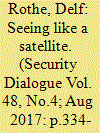

|
|
|
|
|
| Summary/Abstract |
The article furthers the debate on environmental security by highlighting the role of visual technologies such as satellite remote sensing in the construction of threats and risks. It provides a rereading of the critical literature on environmental security through the lens of Actor-Network Theory and argues for understanding environmental security as a form of ontological politics. A theoretical framework around the notion of visual assemblage is developed that accounts for the hybrid, socio-technical character of visual technologies like satellite remote sensing, and shows how these render environmental risks and threats visible, intelligible, and thereby governable. Equipped with this framework, the article traces the development of a visual assemblage of satellite remote sensing from the early days of the Cold War until today and reveals its close co-evolution with environmental security discourses and practices. Three major contemporary remote sensing projects are analyzed to reveal how this global visual assemblage enacts multiple versions of environmental security: as resilience of local populations and ecosystems, as a series of local risk factors that become manageable through market-based risk management, and through a ‘meteorology of security’ based on the collection, harmonization, and automated analysis of big (environmental) data from multiple sources.
|
|
|
|
|
|
|
|
|
|
|
|
|
|
|
|
| 10 |
ID:
160118


|
|
|
|
|
| Summary/Abstract |
In recent years, satellite imagery, previously restricted to the defence and intelligence communities, has been made available to a range of non-state actors as well. Non-governmental organisations, journalists, and celebrities such as George Clooney now use remote sensing data like digital Sherlock Holmeses to investigate and reveal human rights abuses, political violence, environmental destruction, and eco-crimes from a distance. It is often said that the increasing availability and applicability of remote sensing technologies has contributed to the rise of what can be called ‘satellite-based activism’ empowering non-state groups to challenge state practices of seeing and showing. In this article we argue that NGO activism is not challenging the sovereign gaze of the state but, on the contrary, actually reinforcing it. We will bolster our arguments in this regard in two prominent fields of non-governmental remote sensing: human rights and environmental governance.
|
|
|
|
|
|
|
|
|
|
|
|
|
|
|
|
| 11 |
ID:
077353


|
|
|
|
|
| Publication |
2007.
|
| Summary/Abstract |
This article engages with a form of visual culture that is, W. J. T. Mitchell (2002: 170) reminds us, `not limited to the study of images and media', but extends also `to everyday practices of seeing and showing'. In the spirit of this openness to multiple manifestations of the domain of the visual and visual practices, the article explores how a particular mode of vigilant or watchful visuality has come to be mobilized in the `homefront' of the so-called war on terror. In homeland security programmes from border and financial screening to Highway Watch, how has sight become represented as the sovereign sense on the basis of which security decisions can be taken? Taking its illustrative cue from Paul Haggis's film Crash, and from a body of work that conceives of touch as `integral to' seeing, the article asks how we might subvert watchful politics by seeing seeing differently.
|
|
|
|
|
|
|
|
|
|
|
|
|
|
|
|
| 12 |
ID:
151649


|
|
|
|
|
| Summary/Abstract |
War experiences are a material of political currency, invoked, appropriated, and ‘written’ in particular configurations to sustain, complicate, and contest narratives about war. This occurs through and within the same relations of power that are intrinsic to the conduct of war as war-experiencing subjects comprise a political vocabulary of selves and others that populate and operate within war’s wider social (re)production. To track these power relations and consider implications for how dominant accounts of war can be complicated and contested, the article is grounded in an analysis of the visual regimes at work in footage, photographs, and testimony relating to the shooting of a group of people by an American Apache helicopter in Baghdad, Iraq in 2007. The event was publicised on a dedicated website and dubbed ‘Collateral Murder’ by WikiLeaks in 2010. Analysis of the website reveals how visual modes and the experiences of war subjects accompany each other, revealing war in contrasting locations of sight and violence: the ‘view from above’, the ‘view from below’, and the view of the ‘on-the-ground’ soldier eyewitness. Taken together these discursively produce ‘Collateral Murder’ and contest the dominance of war known through the experience of those who wage it ‘from above’.
|
|
|
|
|
|
|
|
|
|
|
|
|
|
|
|
| 13 |
ID:
144814
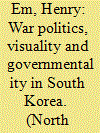

|
|
|
| 14 |
ID:
112764
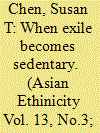

|
|
|
|
|
| Publication |
2012.
|
| Summary/Abstract |
Waltraud Kokot and her coauthors stated ' … . despite a necessary focus on transnational networks and movement, ethnographic studies of diaspora must also not neglect the realities of sedentary diasporic life.' Taking such a call as my point of departure, this article explores the quotidian experiences of 'in exile' specific to a subgroup of Tibetans in Dharamsala, north India, who have for a couple of decades at least described themselves as the 'India-born'. Secondly, it particularly attends to the sensory domains of these Tibetans' local/Indian experiences and in turn highlights the geo-affinity that they ambivalently feel for the place where they are at once native and exilic. Demonstrated in the article are the ongoing processes through which individuals, feeling marked by the displacement of the nation to which they belong, realize their Tibetan attributes in the context(s) they in varied ways perceive as 'Indian'.
|
|
|
|
|
|
|
|
|
|
|
|
|
|
|
|
|
|
|
|
|